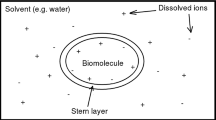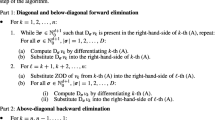Abstract
The nonlinear Poisson–Boltzmann equation (PBE) is a widely-used implicit solvent model in biomolecular simulations. This paper formulates a new PBE nonlinear algebraic system from a mortar finite element approximation, and proposes a new minimization protocol to solve it efficiently. In particular, the PBE mortar nonlinear algebraic system is proved to have a unique solution, and is equivalent to a unconstrained minimization problem. It is then solved as the unconstrained minimization problem by the subspace trust region Newton method. Numerical results show that the new minimization protocol is more efficient than the traditional merit least squares approach in solving the nonlinear system. At least 80 percent of the total CPU time was saved for a PBE model problem.
Similar content being viewed by others
References
Y. Achdou, Y. Maday, and O. Widlund, Iterative substructuring preconditioners for mortar element methods in two dimensions, SIAM J. Numer. Anal., 36 (1999), pp. 551–580.
N. A. Baker, Improving implicit solvent simulations: a Poisson-centric view, Curr. Opin. Struc. Biol., 15 (2005), pp. 137–143.
N. Baker, D. Sept, M. Holst, and J. A. McCammon, The adaptive multilevel finite element solution of the Poisson–Boltzmann equation on massively parallel computers, IBM J. Res. Develop., 45 (2001), pp. 427–438.
N. A. Baker, D. Sept, S. Joseph, M. Holst, and J. A. MoCammon, Electrostatics of nanosystems: Application to microtubules and the ribosome, Proc. Nat. Acad. Sci. USA, 98 (2001), pp. 10037–10041.
R. Bank and M. Holst, A new paradigm for parallel adaptive meshing algorithms, SIAM Rev., 45 (2003), pp. 291–323.
F. B. Belgacem, The mortar finite element method with Lagrange multipliers, Numer. Math., 84 (1999), pp. 173–197.
C. Bernardi, Y. Maday, and A. Patera, A new nonconforming approach to domain decomposition: The mortar element method, in H. Brezis et al., eds., Nonlinear Partial Differential Equations and Their Applications, vol. XI, Pitman Res. Notes. Math. Ser., 299, Longman Sci. Tech., Harlow, 1994, pp. 13–51.
M. A. Branch, T. F. Coleman, and Y. Li, A subspace, interior, and conjugate gradient method for large-scale bound-constrained minimization problems, SIAM J. Sci. Comput., 21 (1999), pp. 1–23.
S. C. Brenner and L. R. Scott, The Mathematical Theory of Finite Element Methods, 2nd edn., Springer, New York, 2002.
R. H. Byrd, R. B. Schnabel, and G. A. Shultz, Approximate solution of the trust region problem by minimization over two-dimensional subspaces, Math. Progr., 40 (1988), pp. 247–263.
W. Chen, Y. Shen and Q. Xia, A mortar finite element approximation for the linear Poisson–Boltzmann equation, Appl. Math. Comput., 164 (2005), pp. 11–23.
T. F. Coleman and Y. Li, An interior, trust region approach for nonlinear minimization subject to bounds, SIAM J. Optimization, 6 (1996), pp. 418–445.
T. F. Coleman and Y. Li, On the convergence of reflective Newton methods for large-scale nonlinear minimization subject to bounds, Math. Progr., 67 (1994), pp. 189–224.
M. E. Davis, J. D. Madura, B. A. Luty, and J. A. McCammon, Electrostatics and diffusion of molecules in solution: Simulations with the University of Houston Browian dynamics program, Comp. Phys. Comm., 62 (1991), pp. 187–197.
L. Debnath and P. Mikusinnski, Introduction to Hilbert Spaces with Applications, Academic Press, New York, 1990.
S. C. Eisenstat and H. F. Walker, Globally convergent inexact Newton methods, SIAM J. Optim., 4 (1994), pp. 393–422.
I. Ekeland and R. Témam, Convex Analysis and Variational Problems, SIAM, Philadelphia, 1999.
K. E. Forsten, R. E. Kozack, D. A. Lauffenburger, and S. Subramaniam, Numerical solution of the nonlinear Poisson–Boltzmann equation for a membrane-electrolyte system, J. Phys. Chem., 98 (1994), pp. 5580–5586.
G. H. Golub and C. F. van Loan, Matrix Computations, 3rd edn., John Hopkins University Press, Baltimore, MD, 1996.
J. Hoffman and A. Logg, PUFFIN Web page: http://www.fenics.org/puffin/, 2004.
J. Hoffman, J. Jansson, A. Logg, and G. N. Wells, DOLFIN Web page: http://www.fenics.org/dolfin, 2003.
M. Holst and F. Saied, Numerical solution of the nonlinear Poisson–Boltzmann equation: Developing more robust and efficient methods, J. Comput. Chem., 16 (1995), pp. 337–364.
M. Holst, N. Baker, and F. Wang, Adaptive multilevel finite element solution of the Poisson–Boltzmann equation; I: Algorithms and examples, J. Comput. Chem., 21 (2000), pp. 1319–1342.
B. Honig and A. Nicholls, Classical electrostatics in biology and chemistry, Science, 268 (1995), pp. 1144–1149.
B. Al-Lazikani, J. Jung, Z. Xiang, and B. Honig, Protein structure prediction, Current Option in Chemical Biology, 5 (2001), pp. 51–56.
B. P. Lamichhane and B. I. Wohlmuth, Mortar finite elements for interface problems, Computing, 72 (2004), pp. 333–348.
The MathWorks, Inc., MATLAB Partial Differential Equation Toolbox 1.0.8 Web page: http://www.mathworks.com/products/pde/, 2005.
J. J. Moré and D. C. Sorensen, Computing a Trust Region Step, SIAM J. Sci. Stat. Comput., 3 (1983), pp. 553–572.
J. Nocedal and S. J. Wright, Numerical Optimization, Springer, New York, 2000.
W. Rocchia, E. Alexov, and B. Hoing, Extending the applicability of the nonlinear Poisson–Boltzmann equation: Multiple dielectric constants and multivalent ions, J. Phys. Chem. B, 105 (2001), pp. 6507–6514.
B. Roux and T. Simonson, Implicit solvent models, Biophys. Chem., 78 (1999), pp. 1–20.
C. Tanford, Physical Chemistry of Macromolecules, John Wiley & Sons, New York, NY, 1961.
Y. N. Vorobjev and H. A. Scheraga, A fast adaptive multigrid boundary element method for macromolecular electrostatic computations in a solvent, J. Comput. Chem., 18 (1997), pp. 569–583.
J. Wagoner and N. A. Baker, Solvatin forces on biomolecular structures: a comparison of explicit solvent and Poisson–Boltzmann models, J. Comput. Chem., 25 (2004), pp. 1623–1629.
B. I. Wohlmuth, A V-cycle multigrid approach for mortar finite elements, SIAM J. Numer. Anal., 42 (2005), pp. 2476–2405.
Author information
Authors and Affiliations
Corresponding author
Additional information
AMS subject classification (2000)
65N30, 65H10, 65K10, 92-08
Rights and permissions
About this article
Cite this article
Xie, D., Zhou, S. A new minimization protocol for solving nonlinear Poisson–Boltzmann mortar finite element equation . Bit Numer Math 47, 853–871 (2007). https://doi.org/10.1007/s10543-007-0145-9
Received:
Accepted:
Published:
Issue Date:
DOI: https://doi.org/10.1007/s10543-007-0145-9




